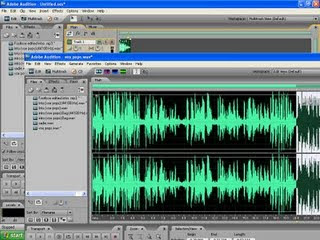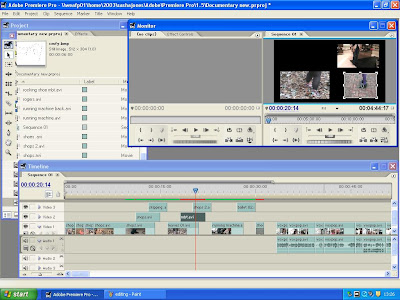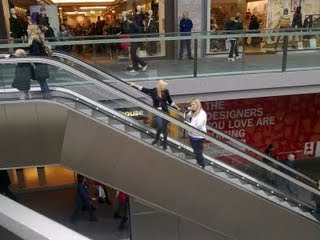Our media product does not use, develop or challenge the forms and conventions of a real media product, as it follows them. It follows them in many different ways such as.
The Framing of shots

 http://www.youtube.com/watch?v=CEtRGQWObmY&feature=PlayList&p=B807AC4FFC264AE6&playnext=1&playnext_from=PL&index=41
http://www.youtube.com/watch?v=CEtRGQWObmY&feature=PlayList&p=B807AC4FFC264AE6&playnext=1&playnext_from=PL&index=41
The first image is a image of our documentary and the second is taken from http://www.youtube.com/ of a channel four documentary (the link for the documentary above). As you can see the same framing is used within the shots as the interviewee is to on side of the screen and in the mise en scene it is a natural environment with objects relating back to the subject within the documentary.
The framing of different shots is very important. The framing of shots represent the different people being interviewed, as you can see by the interview in our documentary we have represented that girl as young as she is located in her bedroom to signify that she is young. Also to show that she like lots of different show there a different shoes in the background to imply she has lots of different shoes placed all around her bedroom.
The Graphics
 http://www.channel4.com/programmes/man-on-earth
http://www.channel4.com/programmes/man-on-earth
To display the name of an interviewee graphics are used. As you can see both graphics use a plain easy to read front and a bright colour that stands out against all backgrounds. Our graphics are purple as some of the mise en scenes used we either to dark or to light for plain colours like black or white so we went with purple, as it links with are title sequence tying the documentary together with the graphics used.
 http://www.channel4.com/programmes/katie-my-beautiful-facetie-my-beautiful-face
http://www.channel4.com/programmes/katie-my-beautiful-facetie-my-beautiful-face
Cut aways are used to split up different footage. The cut aways that are used are always relevant to the subject or the issues that is being raised at the time. The examples above are cut aways to establish were different interviews are taking place.
The Archive material


http://www.youtube.com/watch?v=stm3qv5mTV0
Archive footage is footage that already exists, the archive footage that is used in our documentary is of a DVD about MBTS this is to help the viewer understand about the shoes. But archive footage can also be used to show other clips of music videos and show.
The Voice overs
Voice overs in documentaries are often used to narrate the programme an tell people what is going on. This style of documentary is known as Expository as they all use a ‘voice of god’. Our documentary follows in this style making it an Expository style of documentary.
The Narrative structure
The most popular structure for documentaries is a linear structure, so we decided to follow this structure. As we start by talk about all the different type of shoes their history moving on to the move popular style of shoe of today.
2. How effective is the combination of your main product and ancillary texts?
All of the ancillary tasks are linked connect the documentary together and so the audience isn’t confused as to what it is and what it’s about. We have linked the different tasks within these different ways.
The Images

To follow the code and conventions of a news paper advert, the print advert that we designed is in a landscape style. The reason for this is when buying space in a newspaper, landscape designs are easier as they can divide into smaller sections we putting then all on one page. Also if it is in a landscape form then the advert can be advertised easier in other forms such as on a billboard.
Music and Voice overs
The Advertising
To advertise my documentary the print and the radio advert were created. Below is a list of all the different places that I would have them printed and played.
 We will also have our radio advert advertised to a section of local radio stations for different areas and a section of DAB radio stations as then the advert is getting out to all types of different listeners in all different forms.
We will also have our radio advert advertised to a section of local radio stations for different areas and a section of DAB radio stations as then the advert is getting out to all types of different listeners in all different forms.
Our radio advert would be scheduled for different times during the day. These times would be mostly prime time for example between the time of 7 am and 10am and people are on there way to work listening to the radio of on there way to School/University people often listen to the radio when travelling to work in the car or on there Phone/IPod . Another time of the day is lunch time 12pm and 2 pm as people are on lunch breaks and may put the radio on or often people leave the radio on thought out their working day. Another main time is in the evening 4pm till 6pm as this is the time that most people will be heading home and tuning into the radio or arriving home and putting the radio on, also as DAB has come about and we would advertise on some DAB stations as well they may listen to the radio on their television at home or on the internet.
It doesn’t really matter as to which day the print advert is advertised as people can read newspapers on different days and at different times, but it would make sure that the advert goes out in all the different papers on the release date of the documentary.
3. What have you learned learned from you audience feedback?
Audience feedback is very important as it is the audience that is watching you product and if they don’t like it or understand it then the wont watch it. By receiving our audience feedback it has then made use realised some changes that need to be made in order to gain our viewers and what things would kept our viewers watching.
To gather audience feedback we arranged a focus group of different people that were all within are target audience. Below is a video of the feedback we gained from the focus group.
We also played our documentary to different people to gain a mixture of feedback from a mixture of different people. Below is voice clips of some of the questions that they were asked.
From our audience feedback I learnt that the opening titles were effective and looked of a professional standards. All of the context of the footage and interviews were all relevant. The camera work was effective but some of the shots were a big jumpy.
One of the main improvements were the sounds levels as they differed within different interviews and the voice over sounded different to the other sound. Some found this to be effective as you were able to tell the differences and others were distracted by the sounding of it.
The scheduling and the channel is perfect for the type of the documentary and for the target audience. People understood the aim of the documentary and felt the energy that we tried to create. The music played a big part in this and people felt this by the music in the opening titles and on the radio advert as it was young with attracted the target audience.
The radio and print advert for filed their purpose as after the target audience looking and listening to each they would then go on and watch the rest of the documentary. They also related each of the print, radio and the documentary with each other and all thought they matched with the use of songs and the image being the same.
4. How did you use media technologies in the construction and research, planning and evaluation stages?
I used many different technologies during the different stages of making the documentary. From using the internet to help me with my planning and research, then the different cameras, microphones and tripods used during filming. Then the different software used for the actual construction of the documentary, to the movies and images used during the evaluation stage. This is a short film to show how I used the different technologies.The use of technology is very important as with out all the different technology we would haven’t been able to get this done, from the filming process down to the editing. All the different levels of technologies that I used was very useful an effective. Different programmes and light weight easy to handle equipment made it easy to film, record and editing in the easiest more effective way. For example the filming was easier done on and then easily uploaded onto the computer, to the correct software of Adobe Premier, which was effective to use and was able to allow you to edit in a professional manner and within a lot of detail.






















 For this shot we held the camera still and turned it around to get a panning shot of the shop Office.
For this shot we held the camera still and turned it around to get a panning shot of the shop Office.























